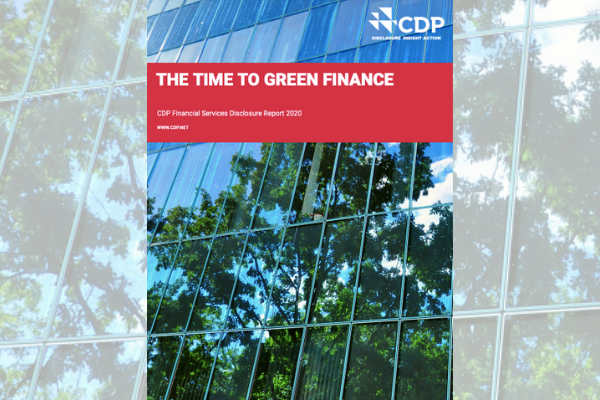
Submitted by firuze.alpaydin on May 6, 2021
CDP is ideally positioned to provide this assessment. The CDP system has provided the most comprehensive, comparable and TCFD-aligned environmental data and insights to capital markets for over 20 years. It is now expanding to serve more of the capital markets; leveraging a broad range of asset classes as authorities to request environmental disclosures – such as through the bond markets or banks requesting disclosures from their lending clients. Beginning with the Financial Services Climate Change Questionnaire 2020, CDP asks for disclosures from financial institutions on the impacts they finance in the wider economy. The disclosures allow for a baseline assessment of climate-related risks, opportunities and impacts in financing portfolios; and of how banks, asset owners, asset managers and insurance companies are preparing for the net-zero carbon transition.
The Time to Green Finance, released today, shows that almost all climate-related impacts and risks of global financial institutions come from financing the wider economy.
The GHG emissions associated with financial institutions' investing, lending and underwriting activities are on average over 700 times higher than their direct emissions, according to a first-of-its-kind report by non-profit CDP, which runs the global environmental disclosure system.
Given the growing momentum of financial institutions announcing net-zero targets, CDP’s report shows that the sector must take further action to align portfolios with a net-zero carbon economy. Under half of the banks (45%), asset owners (48%) and asset managers (46%) report taking action to align investments with a well below 2-degree Celsius goal, and just 27% of insurers are doing so for underwriting portfolios. Examples of such actions include setting science-based emissions reduction targets, reducing portfolio emissions through engagement with companies and investing in renewable energy.
In addition to underreporting portfolio emissions, financial institutions are also underestimating climate-related risks. Financial institutions more commonly identify direct operational climate-related risks, such as physical damage to their operations (41%), but the vast majority are not yet reporting credit risks (65%), such as borrowers’ default on loan repayments and market risks (74%), such as stranded assets and financial asset price devaluation.
Yet these credit and market risks have a much higher reported potential financial impact (over US$1 trillion combined versus just US$34 billion for the operational risks reported). This shows that many financial institutions do not yet report and/or manage their most significant climate-related risks – those associated with financing.
Conversely, financial institutions appear to be focused on low-carbon transition opportunities. 76% identify opportunities in sustainable finance products like sustainability-linked loans, green and transition bonds, sustainable investment funds and insurance solutions – worth up to US$2.9 trillion.
Most financial institutions reported some board-level oversight of climate-related issues, however, this is largely focused on their direct operations rather than financing activities.
Here are the key findings from the report:
1- Almost all financial institutions’ climate impact and risk is driven by the activities they finance in the wider economy, yet the data suggests that this is not yet where the focus is for a large number of institutions.
2- On top of providing green finance, the finance sector must become green. While there are signs of financial institutions committing to align their portfolios with a net-zero carbon world, much work still needs to be done.
3- Financial institutions definitely see opportunities for returns on financing the transition to a low carbon, deforestation-free, water-secure future – 76% see opportunities in offering sustainable finance products and services.
4- Disclosures suggest financial institutions are underestimating their climate-related risks.
5- Financial institutions can create a feedback loop to decarbonize and enhance the resilience of the economy as a whole; engagement with portfolio companies is a key part of this. It is more common for banks to indicate they are engaging with their portfolios on climate-related issues, compared to other industry activities.
6- Most financial institutions now have some board-level oversight of climate-related issues, however there are signs boards could sharpen their focus on issues that really matter.
7- When it comes to incorporating climate-related considerations, insurance companies are currently more focused on their investments than the underwriting they provide.
8- Environmental impact of financing portfolios goes beyond climate change, but currently the issues of deforestation and water security are assessed by fewer institutions in making financial decisions, compared to climate change.





